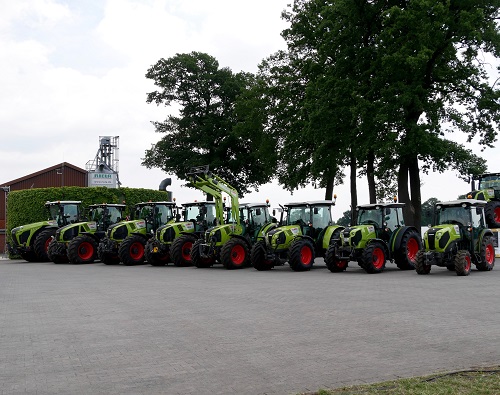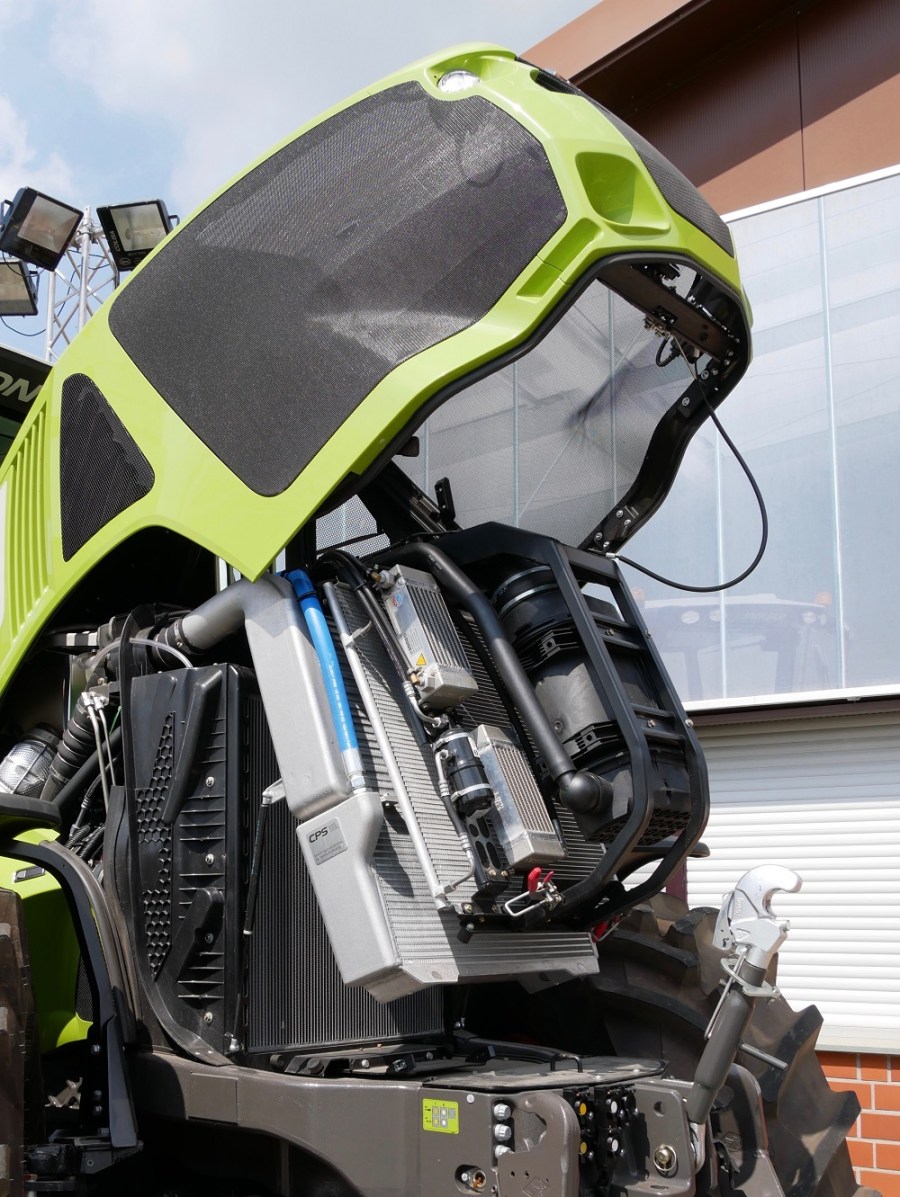Performance tweaks on its Arion and Axion range has resulted in new tractors from Claas with impressive pulling power, among other changes. CPM heads to Germany to see what the manufacturer has in store for 2018.
The 445hp Arion 960 produces a pretty impressive 1860Nm torque from 1400rpm.
By Jane Brooks
It was Claas’ range of new generation Arion 600 and 500 tractors together with the new 445hp Axion 960, that attracted 120 agricultural journalists from all over Europe to the company’s recent press launch at Hof Loermann, in Westphalia, Germany.

A line-up of Claas tractors at Hof Loermann, in Westphalia greeted 120 members of the European agricultural press.
But for the UK contingent, it was an opportunity to find out whether Claas is delivering on its post-Brexit commitment – work is reportedly well underway on the company’s new state-of-the-art UK headquarters building, sited in a prominent position adjacent to the A14 at Saxham Business Park near Bury St Edmunds, Suffolk.
Claas claims the multi-million pound project not only shows its commitment to the UK but also its continuing support of West Suffolk where the company’s one of the main employers in the area.
The Claas Arion tractor range has undergone several changes, not least a horsepower boost, bringing the new top-line Arion 660 into the 200hp plus power range.
Axion adds more power
The new generation of Arion 500 models all retain the John Deere 4.5-litre four-cylinder engine of previous models. But a new 125hp Arion 510 has been added to the lower end of the range to join the Arion 530, which comes in at 135hp, the final tractor in the 500 range is the 165hp Arion 550.
Looking at the six-cylinder Arion 600 series, a new top-of-the-range Arion 660 will be available in 2018, rated at 185hp, it’s the only Arion power-boost model and is fitted with the Claas Power Management system, which boosts output up to 205hp.
Updates include the new CIS+ system, the new CEBIS terminal, updated Hexashift and ATIC transmissions and Claas’ Proactiv front axle suspension. CIS, CIS+ and the new CEBIS Touch offer three different options for models in the Arion 600 and 500 ranges.
Hexashift powershift transmission is available on all versions and includes Smart Stop, which allows the tractor to be stopped on the brakes (without using the clutch) – a useful feature for loader tractors. Alternatively the CIS+ and CEBIS versions can be supplied with the continuously variable (stepless) CMATIC transmission.
Claas says the CIS version has been kept deliberately simple, with mechanical spool valves and the CIS display, whereas electronic spool valves and the CIS colour ‘A’ pillar display are standard with CIS+. Both versions have a multi-function armrest, with Electropilot four-way control lever and Drivestick to operate the transmission.
The CEBIS version features a redesigned CEBIS 30cm touch display terminal, which is also on the Axion 800 and 900 tractors and intuitive ‘Direct Access’ as well as the CMOTION multifunction control lever, which can be operated using just three fingers.
The four-cylinder Arion 500 and the six-cylinder 600 range all retain a revised version of the John Deere diesel particulate filter (DPF) engines of their predecessors, but also have a selective catalytic reduction (SCR) convertor and use AdBlue (diesel exhaust fluid) to meet Stage IV (Tier 4f) engine emission regulations.
The engine updates also produce a new torque curve giving more power at lower revs. On the 600 series, lower idling speeds, which are reduced from 800 to 650 rpm, should lower fuel consumption.
New Arion 600 and 500 models have the option of the new Proactiv front axle suspension, developed by Claas. The company says this optimally suspends the tractor weight on front axle due to the triangular arrangement of two suspended cylinders, which are angled outwards.
This ‘Intelligent control’ provides active roll stabilisation on bends and also reduces pitching movements during braking and acceleration, says Claas. Additionally, when driving with heavy implements attached, it’s claimed to reduce bounce.
Another new feature, intended to make tractor handling faster and easier when undertaking steering intensive work such as using a front loader, is the Claas Dynamic Steering system.
Claas say this enables the driver to change the number of turns of the steering wheel needed to achieve the same steering lock at the press of a button. Adjustment takes place in two different automatic programmes each with two levels, and a manual programme with four intensity levels.
Although available with a standard five-pillar cab, options on the Arion range include a four-pillar cab. Already available on the Axion 800 and 900 models it gives an uninterrupted field of vision to the drivers’ left hand side.
The most noticeable change to the Axion series tractors is, however, the use of a Dana front axle, which has replaced the Carraro axle previously used on the range.
Other options include 42-inch (1m) rims and 1.95m maximum tyre diameter for Arion 630 models and above, LED lighting and in addition to the 110 l/min load-sensing system, an optional new 150 l/min system is available.
Also the handbrake has disappeared, replaced by a park function, which has been added to the left-hand forward/reverse shuttle lever.
Axion adds more power
The next generation of Claas Axion tractors now includes five models ranging from the 325hp Axion 920 up to 445hp Axion 960. They still feature the 8.7-litre FPT six-cylinder engine, however AdBlue diesel exhaust fluid is now used, although DPF and EGR are not needed.
They feature a new variable geometry turbocharger and in common with the 500 and 600 series have a new torque curve giving more power at lower revs. This develops 18% more torque than previously at a lower speed (up to 200 rpm lower). Claas says this reduces fuel consumption and guarantees optimum driving performance for all field and transport applications.
As with the Arion series, engine idle speed has been reduced to 650rpm, which the company say leads to further fuel savings of approximately 2 l/hr. In ECO PTO mode, up to 95% of the maximum engine output is transferred to the PTO shaft despite the reduced engine speed, allowing heavy implements to be operated at a lower engine speed.
None of the 900 series tractors feature a power boost, as full power is available from the start. According to Claas the 445hp Arion 960 produces a pretty impressive 1860Nm torque from 1400rpm. The rest of the updated Axion 900 models have gained an additional 5hp.
Extra power needs some beefed up hardware and all 900 Series tractors are fitted with an updated continuously variable ZF Terramatic transmission. The continuously variable Claas CMatic transmission control system uses a new generation of software incorporating many customer requirements identified under real-world conditions.
For example, cruise control can be deactivated with the accelerator pedal, and the transmission adjusts more rapidly to the job in hand as the driver can switch between two saved engine droop values simply by pressing a button.
The new Axion 900 comes with the new Cebis terminal with a 30cm touch display and ergonomic armrest with CMotion multifunction control lever for convenient operation of all the main functions using just the thumb and first two fingers.
The new Cebis offers many new functions – its intuitive operating structure is based on the familiar Cebis generation and has been optimised for touch display use.
One convenient feature is the quick-adjustment facility for frequently used tractor functions using Direct Access, simply by tapping the machine silhouette on the Cebis touch display.
The precise Claas GPS steering systems are available ex-factory across all models in the range. The Claas Telematics telemetry solution is part of the standard equipment package on all Axion 900 tractors.
They also all have load-sensing hydraulics with an output of 150 or 220 l/min and release levers for all hydraulic couplings at the rear. Up to eight spool valves are available, which are operated electronically by means of rocker switches in the armrest and the ElectroPilot four-way control lever.
The function buttons on the armrest and multifunction control lever can be configured for any of the spool valves. This reduces the driver’s workload, especially during combined operations, as there’s less need to change hand position.
Using Cebis, the driver can assign priority to any spool valve. The pre-set oil volume for the prioritised spool valve then remains almost constant even when other spool valves are in use.
The driver can also select the speed at which a spool valve delivers the maximum pre-set oil flow after activation. This allows hydraulic motors or smaller hydraulic rams, to be operated more gently with less material wear.
The new Axion 900 tractors will be unveiled to the public for the first time at Agritechnica 2017, and will be available to purchase from Spring 2018.
Meeting emissions – what the technobabble actually means
Claas has applied EGR (exhaust gas recirculation) and SCR (selective catalytic reduction) technologies to its products. Both are proven approaches to reducing oxides of nitrogen (NOx) emissions from the exhaust gases of diesel engines, but what do they actually do and does this affect performance?
SCR is generally regarded as the best solution for high-powered agricultural machinery because it’s a post-combustion, after-treatment that occurs in the exhaust system itself and doesn’t affect the engine’s ability to create power and torque.
It’s more suited to farms with large vehicle fleets, as the technology requires the use and storage of Diesel Exhaust Fluid (DEF) – a liquid-reductant agent. This is made from a mixture of high-purity urea (32.5%) and deionized water (67.5%) and is usually sold as AdBlue here in the UK. It needs to be kept out of direct sunlight, and between the temperatures of -6°C and 25°C – it’ll freeze at -12°C.
SCR reduces levels of NOx using ammonia as a reductant within a catalyst system. AdBlue is injected through a special catalyst into the exhaust stream of a diesel engine. The chemical reaction or ‘reduction’ uses AdBlue as the reducing agent, which reacts with NOx to convert pollutants into nitrogen, water and tiny amounts of CO2. All of these naturally occur in the atmosphere and are expelled out of the exhaust.
Whereas SCR technology works outside of the engine, EGR technology reduces the amount of oxygen inside the cylinder. It generally costs less, and there are less follow-up costs, however EGR technology is potentially harder on an engine.
EGR works by means of an electronic valve that diverts a proportion of the exhaust gas back into the air intake. It usually only kicks in when the engine has reached a pre-set operating temperature.
This lowers the amount of oxygen so that the fuel doesn’t burn completely which reduces the cylinder temperature and a lower amount of NOx is formed within the engine.
But the lower temperature results in soot particles forming in the engine, which have to be filtered through a Diesel Particulate Filter (DPF) to stay within emissions standards.
The DPF must be regenerated by occasionally burning off the soot; also EGR valves sometimes become blocked with a build-up of particles, which can lead to a reduction in power. However this is usually picked up by the electronic control unit on a tractor and triggers a warning light or icon.
Claas is currently using both technologies in its engines, tending to favour SCR for higher horsepower tractors and EGR in smaller tractors, although in the end it’s dependent on the engine make and drive technology that’s utilised on each model.




